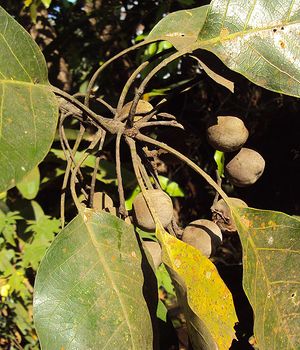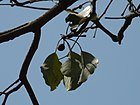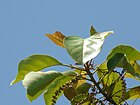Note: This is a project under development. The articles on this wiki are just being initiated and broadly incomplete. You can Help creating new pages.
Difference between revisions of "Terminalia bellerica roxb - Bibhitaki"
m (HPNadig moved page Bibhitaki (Terminalia bellerica) to Terminalia bellerica - Bibhitaki) |
|||
| Line 2: | Line 2: | ||
| − | '''Bibhitaki''' is growing widely throughout the Indian subcontinent, Sri Lanka and SE Asia. In the Traditional system of medicine like | + | '''Bibhitaki''' is growing widely throughout the Indian subcontinent, Sri Lanka and SE Asia. In the Traditional system of medicine like Siddhaand Unani, medicinaluses have been described as it is works in disease of every system. |
| − | == | + | ==Uses== |
| + | {{Uses|Indigestion}}, {{Uses|Respiratory problems}}, {{Uses|diarrhoea}}, {{Uses|chronic constipation}}, {{Uses|hoarseness}}, {{Uses|coughs}}, {{Uses|sore eyes}}, {{Uses|Diarrhea}}, {{Uses|Sore throats}} | ||
| − | + | ==Parts Used== | |
| − | + | {{Parts Used|Seeds}}, {{Parts Used|Fruits}}. | |
| − | |||
| − | ==External | + | ==Chemical Composition== |
| + | Beta-sitosterol,gallic acid,ellagic acid,ethyl gallate,galloyl glucose,chebulagic acid<ref name="chemical composition"/> | ||
| + | |||
| + | ==Common names== | ||
| + | {{Common names|kn=Thare, Tare Mara|ml=Thani, Thannikka|sa=Akshah, Kasaghnah|ta=Semmaram, Vibidagam|te=Karshaphalamu|hi=Bahuvirya, Bahera|en=Bedda nut tree, Belliric myrobalan}} | ||
| + | |||
| + | ==Properties== | ||
| + | Reference: Dravya - Substance, Rasa - Taste, Guna - Qualities, Veerya - Potency, Vipaka - Post-digesion effect, Karma - Pharmacological activity, Prabhava - Therepeutics. | ||
| + | ===Dravya=== | ||
| + | |||
| + | ===Rasa=== | ||
| + | Kashaya (Astringent) | ||
| + | ===Guna=== | ||
| + | Laghu (Light), Ruksha (Dry) | ||
| + | ===Veerya=== | ||
| + | Ushna (Hot) | ||
| + | ===Vipaka=== | ||
| + | Madhura (Sweet) | ||
| + | ===Karma=== | ||
| + | Kapha, Pitta | ||
| + | ===Prabhava=== | ||
| + | |||
| + | ==Habit== | ||
| + | {{Habit|Deciduous Tree}} | ||
| + | |||
| + | ==Identification== | ||
| + | ===Leaf=== | ||
| + | {{Leaf|Simple|alternate|The leaves are spiral, clustered at the twig ends and petiole 3-10 cm long}}<ref name="Leaf"/> | ||
| + | |||
| + | ===Flower=== | ||
| + | {{Flower|Unisexual|2-4cm long|creamy white|5-20|Inflorescence axillary spikes and flowers sessile}} | ||
| + | |||
| + | ===Fruit=== | ||
| + | {{Fruit|Ovoid|3 cm across|slightly 5 ridged|With hooked hairs|1-seeded}} | ||
| + | |||
| + | ===Other features=== | ||
| + | |||
| + | ==List of Ayurvedic medicine in which the herb is used== | ||
| + | * [[Vishatinduka Taila]] as ''root juice extract'' | ||
| + | |||
| + | ==Where to get the saplings== | ||
| + | ==Mode of Propagation== | ||
| + | {{Propagation|Seeds}}. | ||
| + | |||
| + | ==How to plant/cultivate== | ||
| + | The plant has a wide ecological range, succeeding in tropical and subtropical climates, but does not grow above 600 m altitude. It is found at elevations up to 1,400 metres in China<ref name="How to plant/cultivate"/> | ||
| + | |||
| + | ==Commonly seen growing in areas== | ||
| + | {{Commonly seen|Scattered forests}}, {{Commonly seen|sunny mountain slopes}}. | ||
| + | |||
| + | ==Photo Gallery== | ||
| + | <gallery class="left" caption="" widths="140px" heights="140px"> | ||
| + | Bahada (in Oriya) (3395012560).jpg | ||
| + | |||
| + | |||
| + | Baheda (Bengali- বহেড়া) (3393797615).jpg | ||
| + | |||
| + | |||
| + | Baheda (Gujarati- બહેડા) (3393800009).jpg | ||
| + | Baheda (Gujarati- બહેડા) (3393800009).jpg 2,048 × 1,536; 1.46 MB | ||
| + | |||
| + | Bahera (Hindi- बहेड़ा) (3394597674).jpg | ||
| + | Bahera (Hindi- बहेड़ा) (3394597674).jpg 3,264 × 2,448; 3.74 MB | ||
| + | |||
| + | Bahera (in Manipuri) (3392698146).jpg | ||
| + | Bahera (in Manipuri) (3392698146).jpg 3,264 × 2,448; 3.74 MB | ||
| + | |||
| + | Bahera (Urdu- بهيڙا) (3391882571).jpg | ||
| + | Bahera (Urdu- بهيڙا) (3391882571).jpg | ||
| + | </gallery> | ||
| + | |||
| + | ==References== | ||
| + | |||
| + | <references> | ||
| + | <ref name="chemical composition">[https://www.mdidea.com/products/proper/proper06003.html "Phytochemicals"]</ref> | ||
| + | |||
| + | <ref name="Leaf">[https://indiabiodiversity.org/species/show/19316 "Diagnostic description"]</ref> | ||
| + | |||
| + | <ref name="How to plant/cultivate">[http://tropical.theferns.info/viewtropical.php?id=Terminalia+bellirica "Cultivation Details"]</ref> | ||
| + | </references> | ||
| + | |||
| + | ==External Links== | ||
| + | |||
| + | * [http://www.phytojournal.com/archives/2016/vol5issue1/PartC/4-4-28.pdf Terminalia bellerica on Pharmacological activities of Baheda ] | ||
| + | * [http://www.planetayurveda.com/library/bibhitaki-terminalia-bellerica Terminalia bellerica on planet ayurveda] | ||
| + | * [http://www.banajata.org/bahada.htm Terminalia bellerica on banajata.org] | ||
| − | |||
[[Category:Herbs]] | [[Category:Herbs]] | ||
Revision as of 11:58, 11 June 2018
Bibhitaki is growing widely throughout the Indian subcontinent, Sri Lanka and SE Asia. In the Traditional system of medicine like Siddhaand Unani, medicinaluses have been described as it is works in disease of every system.
Contents
- 1 Uses
- 2 Parts Used
- 3 Chemical Composition
- 4 Common names
- 5 Properties
- 6 Habit
- 7 Identification
- 8 List of Ayurvedic medicine in which the herb is used
- 9 Where to get the saplings
- 10 Mode of Propagation
- 11 How to plant/cultivate
- 12 Commonly seen growing in areas
- 13 Photo Gallery
- 14 References
- 15 External Links
Uses
Indigestion, Respiratory problems, diarrhoea, chronic constipation, hoarseness, coughs, sore eyes, Diarrhea, Sore throats
Parts Used
Chemical Composition
Beta-sitosterol,gallic acid,ellagic acid,ethyl gallate,galloyl glucose,chebulagic acid[1]
Common names
| Language | Common name |
|---|---|
| Kannada | Thare, Tare Mara |
| Hindi | Bahuvirya, Bahera |
| Malayalam | Thani, Thannikka |
| Tamil | Semmaram, Vibidagam |
| Telugu | Karshaphalamu |
| Marathi | NA |
| Gujarathi | NA |
| Punjabi | NA |
| Kashmiri | NA |
| Sanskrit | Akshah, Kasaghnah |
| English | Bedda nut tree, Belliric myrobalan |
Properties
Reference: Dravya - Substance, Rasa - Taste, Guna - Qualities, Veerya - Potency, Vipaka - Post-digesion effect, Karma - Pharmacological activity, Prabhava - Therepeutics.
Dravya
Rasa
Kashaya (Astringent)
Guna
Laghu (Light), Ruksha (Dry)
Veerya
Ushna (Hot)
Vipaka
Madhura (Sweet)
Karma
Kapha, Pitta
Prabhava
Habit
Identification
Leaf
| Kind | Shape | Feature |
|---|---|---|
| Simple | alternate | The leaves are spiral, clustered at the twig ends and petiole 3-10 cm long |
Flower
| Type | Size | Color and composition | Stamen | More information |
|---|---|---|---|---|
| Unisexual | 2-4cm long | creamy white | 5-20 | Inflorescence axillary spikes and flowers sessile |
Fruit
| Type | Size | Mass | Appearance | Seeds | More information |
|---|---|---|---|---|---|
| Ovoid | 3 cm across | slightly 5 ridged | With hooked hairs | 1-seeded | {{{6}}} |
Other features
List of Ayurvedic medicine in which the herb is used
- Vishatinduka Taila as root juice extract
Where to get the saplings
Mode of Propagation
How to plant/cultivate
The plant has a wide ecological range, succeeding in tropical and subtropical climates, but does not grow above 600 m altitude. It is found at elevations up to 1,400 metres in China[3]
Commonly seen growing in areas
Scattered forests, sunny mountain slopes.
Photo Gallery
- Baheda (Gujarati- બહેડા) (3393800009).jpg 2,048 × 1,536; 1.46 MB
- Bahera (Hindi- बहेड़ा) (3394597674).jpg 3,264 × 2,448; 3.74 MB
- Bahera (in Manipuri) (3392698146).jpg 3,264 × 2,448; 3.74 MB
References
External Links
- Pages with broken file links
- Ayurvedic Herbs known to be helpful to treat Indigestion
- Ayurvedic Herbs known to be helpful to treat Respiratory problems
- Ayurvedic Herbs known to be helpful to treat diarrhoea
- Ayurvedic Herbs known to be helpful to treat chronic constipation
- Ayurvedic Herbs known to be helpful to treat hoarseness
- Ayurvedic Herbs known to be helpful to treat coughs
- Ayurvedic Herbs known to be helpful to treat sore eyes
- Ayurvedic Herbs known to be helpful to treat Diarrhea
- Ayurvedic Herbs known to be helpful to treat Sore throats
- Herbs with Seeds used in medicine
- Herbs with Fruits used in medicine
- Herbs with common name in Kannada
- Herbs with common name in Hindi
- Herbs with common name in Malayalam
- Herbs with common name in Tamil
- Herbs with common name in Telugu
- Herbs with common name in Sanskrit
- Herbs with common name in English
- Habit - Deciduous Tree
- Index of Plants which can be propagated by Seeds
- Herbs that are commonly seen in the region of Scattered forests
- Herbs that are commonly seen in the region of sunny mountain slopes
- Herbs






